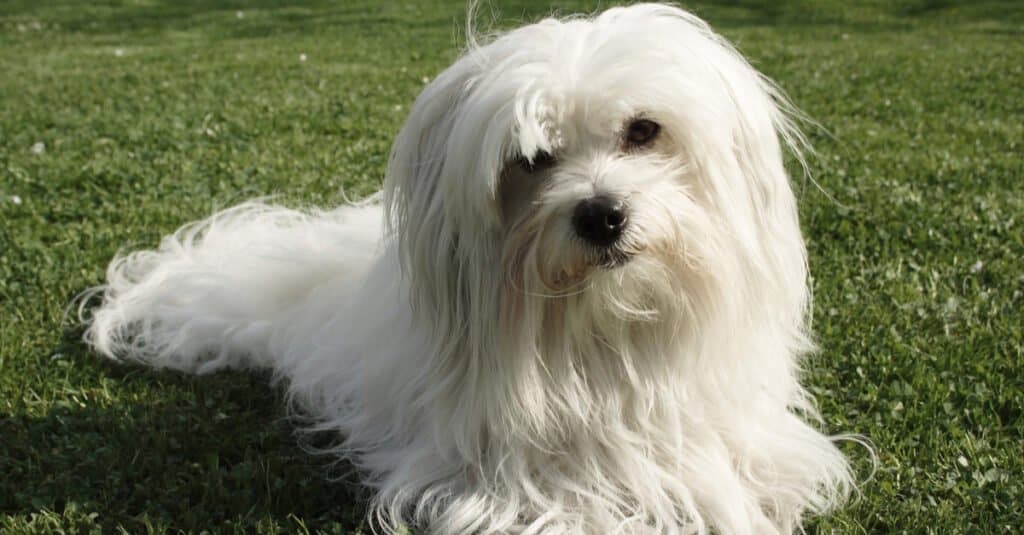Dogs are a man’s best friend — at least, that’s how the age-old saying goes. If you’ve owned a dog (or a pet in general), you know just how deep and meaningful the relationship can be between animal and owner. When you adopt a dog, especially a purebred with hundreds of years of genetic predispositions to study, you usually want to know the average longevity of your new puppy.
If you’ve adopted a coton de Tulear, you luckily have a great breed with a long lifespan. The coton de Tulear dog is an East African dog breed that thrives in families. It has a ton of love to give, meaning the bond between the dog and its owners can become incredibly close in a short amount of time.
In this post, you’ll discover the average life expectancy of a coton de Tulear, understand how to help your coton de Tulear live longer, and learn about common health issues that might affect your coton de Tulear’s lifespan.
Coton De Tulear: How Long Do These Dogs Live?

Coton de Tulear dogs are fairly easy to train and make for a great family pet.
©Jeanette Dietl/Shutterstock.com
On average, coton de Tulears live between 15 and 19 years old. Being a small dog from the non-sporting group, this healthy and sturdy dog has the anatomy to live a long and happy life with its family.
Dr. Jack da Silva, a researcher from the University of Adelaide’s School of Biological Sciences, has done work to discover how and why small dogs live longer than larger dogs. All of their research points to an evolutionary lag. Said da Silva, “We believe the relationship between a dog’s body size and their lifespan may be caused by an evolutionary lag in the body’s cancer defences, which are unable to keep up with the rapid and recent selective breeding of bigger dogs.”
Coton De Tulear Breed Summary and Characteristics

The coton de Tulear dogs are incredibly loyal.
©BIGANDT.COM/Shutterstock.com
The coton de Tulear is an awesome dog breed with charm, wit, and joy. Officially recognized as a breed in 2014, the coton de Tulear is a bit new to the dog competition industry. Breed individuals will vary pup to pup, but these purebred dogs have a reputation of being great companions for families, young children, and even other dogs. Their mental stimulation needs are on the higher side — but if you have any aged children in the house, your coton de Tulear will have their hands (and minds) full of effortless playtime.
The coton de Tulear doesn’t shed but you’ll want to brush it every day to keep it’s coat regal-looking. It’s also prone to separation anxiety. The dog loves its owners deeply, so plan to only be out of the house about three to four hours max. After this point, your coton de Tulear may get destructive.
How to Help Your Coton De Tulear Live Longer

Coton de Tulear dogs are most well known for their soft, smooth coats.
©BORTEL Pavel – Pavelmidi/Shutterstock.com
Like any responsible dog owner, coton de Tulear dog parents want to ensure their already long-lifed dog gets to enjoy all the world has to offer for as long as possible. You can ensure a great life for your coton de Tulear in several ways.
Get the right amount of exercise. Coton de Tulear dogs need moderate amounts of exercise, but they’re not going to beat a whippet at any races. Keep your exercise dog-focused; make sure they’re happy and comfortable while on walks or off-leash in a secure backyard. If you’re not cautious about how they use their body in exercise, your coton de Tulear could pull muscles or cause early degeneration of joints.
Feed your pup correctly. With such a small body, coton de Tulears need to eat just enough to satiate their hunger — not overeat and become overweight. Most weigh somewhere between eight and 15 pounds. If you’re looking to level up your pup’s diet, include enzymes and other minerals to improve the effectiveness of other health solutions you try.
Use preventative medical care. It goes without saying that your dog should have maintenance medications like flea, tick, and heartworms prescribed and taken on a monthly basis. To help your coton de Tulear live longer, consider extra supplements, vaccines, and vet-recommended toys and treats.
Common Coton De Tulear Health Issues

Coton de Tulear dogs come in several different colors and markings.
©Katrina Elena/Shutterstock.com
Did you know that the coton de Tulear is an incredibly healthy dog? While some illnesses and issues exist, the breed receives incredibly high marks for general health — especially for a purebred group.
Some of the issues that do exist in the breed have mild issues and side effects. The most common illnesses or health issues include allergies, eye problems, joint problems, and the occasional heart problem.
Eye problems in coton de Tulears may include progressive retinal atrophy — an illness in which a slow onset of loss of vision will lead to total blindness. Joint issues include hip and elbow dysplasia or spinal disc disease.
Breeders should have their coton de Tulear puppies checked and confirmed with a clean bill of health before new owners take them home. The vet’s health tests include:
- Ophthalmologist evaluation
- Patella evaluation
- Cardiac exam
- Hip evaluation
In the event that your coton de Tulear does develop one of these issues, most diseases (outside of progressive retinal atrophy) have some sort of accepted treatment that maintains your dog’s quality of life.
Interesting Coton De Tulear Longevity Facts

The coton de Tulear has a wavy double coat.
©iStock.com/Melanie Long
Throughout modern history, coton de Tulears have shown their impressive zeal for life at “old” ages. For example, in 2023, a coton de Tulear competed in the National Dog Show and ranked as the oldest in the competition of over 1,700 dogs. Monkey Business, or Monkey as his trainer and owner call him, may be 12 years old in age, but his memory and agility remain sharp as ever. Not only was Monkey the very first coton de Tulear to compete in 2014; since then, he’s racked up dozens of awards — over 80 medals for Best in Miscellaneous Show.
The photo featured at the top of this post is © Cvf-ps, CC BY-SA 3.0
Ready to discover the top 10 cutest dog breeds in the entire world?
How about the fastest dogs, the largest dogs and those that are -- quite frankly -- just the kindest dogs on the planet? Each day, AZ Animals sends out lists just like this to our thousands of email subscribers. And the best part? It's FREE. Join today by entering your email below.
Thank you for reading! Have some feedback for us? Contact the AZ Animals editorial team.







